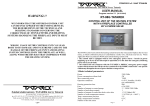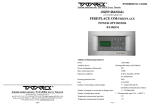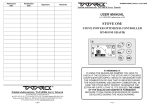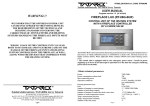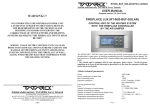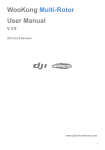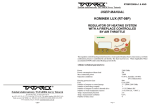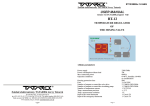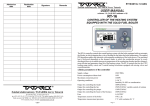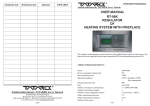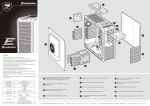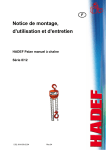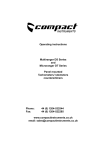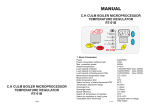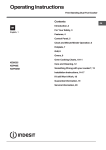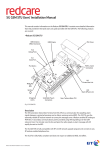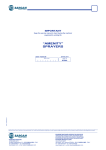Download FIREPLACE OS (RT-08G-OS)
Transcript
WARNING!!! WE INFORM THAT THE OFFERED CONTROL UNIT CAN BE ONLY APPLIED TO THE FITTING DEVICES. THE REQUIREMENTS OF THE TECHNICAL AND BUILDING STANDARDS CONCERNING THE CORRECTNESS OF STOVE AND HEATING RT08GOS/2012/v.1.0/ANG Zakład elektroniczny TATAREK Jerzy Tatarek USER MANUAL v.1.0 (27.01.2012 program version from 1.0) FIREPLACE OS (RT-08G-OS) COMBUSTION OPTIMIZER FOR THE FIREPLACE WITH ACCUMULATION MASS SYSTEMS HANDLING THE FIREPLACE INPUTS MUST BE MET. WRONG USAGE OF THE CONTROL UNIT CAN LEAD BOTH TO ITS DAMAGE AND IN EXTREME CASES TO THE DAMAGE OF THE FIREPLACE INPUT AND HEATING SYSTEM CONTROLLED BY THE FIREPLACE AS WELL , ALONG WITH THE DEVICES THAT COOPERATE WITH THE HEATING SYSTEM. WARNING!!! We inform that in case of systems based on the water cap you should pay attention to the location of mounting the temperature sensor of water in the cap. Because of high temperature maintaining close to the water cap and coming from that both a risk of damaging the sensor and false measurements of temperature, its assembly should be carried out on the pipe channelling water from the water cap beyond the fireplace. Zakład elektroniczny TATAREK Jerzy Tatarek 50-559 Wroclaw, 75 Swieradowska st. ph. (071) 367-21-67, 373-14-88, fax 373-14-58; Tax index number 899-020-21-48; Bank account: BZ WBK S.A. WROCLAW 6910901522-0000-0000-5201-9335 www.tatarek.com.pl.; E-mail: [email protected] 16 1.Basic technical parameters Power Power consumption without load Maximum connection power 230V/50Hz 5W 750W Operation conditions Housing protection class Fuse Number of outputs to control the pumps Number of nonvoltage control outputs Number of outputs to control the air damper drive 0-50 oC, humidity 10-90% (no condensation) IP41 6,3A/250V 3 * 250W/230V/50Hz 1 1 * 5V/500mA/DC Number of water temperature sensors 3 * KTY81 (0..+100oC ) Temp. measurement precision 2 oC Temp. measurement resolution Number of time zones 0,5 oC 4 1 2. Principle of operation With the air damper the control unit controls the combustion process and maintains the embers phase. By lowering the combustion curve in the phase of increasing temperature and by raising it in the phase of decreasing temperature the control unit extends the combustion process. The control unit starts operating as the furnace door closes (sensor of opening the door), supervises the combustion process (temperature sensor of combustion, air damper), shuts off air supply as there's the embers phase in the furnace. Additionally the control unit can increase the chimney draught in the heating phase( flap drive of the by-pass of the heat accumulation module or by turning on the draught generator). In emergency situations (power decrease as well) the air damper opens, enabling a full burn-out of the fuel. The special input for connecting any external control device of CO concentration increases the safety of a fireplace user. The control unit is equipped with its own emergency power supply. The pause in power supply up to 8secs doesn't affect control unit operation because during that time the buffer power supply switches on. If the pause is longer the air damper opens up in emergency and then the control unit switches off. Admission date Realization date Signature CHIMNEY Advantages of the combustion optimizer: -lowering the maximum combustion temperature -extending the combustion process -decreasing fuel consumption -extending the exploitation time of fireplace inputs -shutting off air supply after ending the combustion (preventing the furnace cool-off) -optimal use of the heat accumulation module -cooperation with CO sensor (opening up the fresh airing in emergency) -the control unit can limit the maximum temperature of the combustion FIREPLACE Fig.1 Basic operation scheme of the control unit T1 D1 PP Temperature sensor of the combustion Sensor of opening the furnace door (option) Controllable air damper 2 15 Remarks 2.1 Operation phases of the control unit CE CONFORMITY DECLARATION Ref. No. 58.RT.01.2007/1/B We, ZAKŁAD ELEKTRONICZNY TATAREK Jerzy Tatarek 75 Swieradowska St. , 50-559 Wroclaw declare under our sole responsibility that the product: Combustion Optimizer model: RT-08G-OS is in conformity with the basic requirements included in Directive EMC 2004/108/WE of 15.12.2004 (the electromagnetic compatibility law of 13.04.07) and Directive LVD 2006/95/WE of 21.08.07 (Laws Journal of 2007 No. 155 pos. 1098) regarding the requirements for electric devices. To the conformity evaluation the following harmonized standards were used: PN-EN 60730-2-1: 2002 PN-EN 60730-1: 2002 - Automatic electric regulators for house usage and the like. Part 2-1: Specific requirements regarding electric regulators for electric house devices Automatic electric regulators for house usage and the like. Part 1: General requirements. PN-EN 55022: 2000 Electromagnetic compatibility (EMC)- IT devices Characteristics of radioelectric noises. Acceptable levels and measurement methods Complementary information: Laboratory IASE 51-618 Wroclaw, 1 Wystawowa st. Test report No. 39/DL/I/07 of 22.06.2007 41/DL/I/07 of 03.07.2007 Electronic Engineering Plant TATAREK has initiated management system and complies with the following standard : ISO9001: 2000 CERTIFICATE No. 133/2004 of 01.2004 Polish Foreign Trade Chamber The last two digits of the year in which the CE marking was affixed: 07 Place of issue: Manufacturer representative: Wroclaw Mirosław Zasępa Date of issue: Position: 08.2007 Designer 14 1. Fstop - Standby phase. The control unit awaits opening the door and preparing the fuel for the next heating. In the STOP state the air damper is closed. 2. F0 - Temporary state after switching on the power at the closed door. The air damper is open. Depending on the temperature of the furnace the control unit decides if it has to go to the standby phase Fstop or to continue the process of combustion F1. 3. F0- State after opening the furnace door. The air damper is open. 4. F1 - Start phase. After loading the fuel and its lighting you close the furnace door. It's a signal for the control unit that the combustion cycle has begun. The air damper is fully open. 5. F2 - Heating-up phase. After reaching the limit temperature the pass to the phase F3 follows. 6. F3,4,5 - Phases of temperature increase. The air damper is set depending on the temperature according to the combustion curve 7. F6 - Burning phase. Awaiting the maximum combustion temperature of the process 8. F7 - Phase of decreasing temperature. The air damper is gradually closed 9. F8 - Embers phase. Signalling the demand for replenishing the fuel 8. F9 - Phase of removing the exhaust gases. The air damper first opens up and then closes and there's the pass to the standby phase. ! The control unit can control the fireplace without the opening sensor of the door. In that case the keyboard buttons are used. 2.2 Sensor of combustion temperature Sensor of combustion temperature is a thermocouple type K, which can measure the range 0 oC ..1300 o C . The sensor should be mounted over the exhaust gas output from the furnace 2.3 Limiting the maximum temperature of combustion For the fireplace inputs whose construction requires limiting the maximum temperature of combustion it's possible to program the limit. Exceeding the temperature defined by the parameter "<20> Fireplace T.MAX" causes that the air damper closes to the level of 30% (parameter "<21> ChokeV State T.MAX") and the alarm turns on. The process of shutting the air damper begins at 50 oC before reaching that limit. Turning off the alarm and the return of normal operation of the air damper follows if the temperature decreases again. The default 1300 oC practically indicates that there's no limit (it's the maximum temperature of operation of the temperature sensor). 2.4 Air damper The air damper is mounted on the input of cold air to the combustion chamber. The position of the air damper is calculated by the control unit depending on the combustion process. The change of the position is carried out by the drive of the air damper in 20sec cycles ! In the turn-off state (also the decline of the power) the combustion process is not controlled. In order to prevent CO concentration increase( in case of the partial combustion before reaching the embers phase ) the air damper is opened. 2.5 Increasing the chimney draught During normal operation the heated exhaust gases cool off flowing through the MAC (Heat Accumulation Module). During the heating-up phase, when the fireplace is cold, its draught can be insufficient..The control unit can control the system of increasing the chimney draught with the K1 output. To this output you can connect a actuator of the by-pass flap MAC or draught generator. Depending on the applied actuator and the paramater "<50> K1 MODE" we've got the following possibilities: 3 WARRANTY Version 1: On (chimney) Time Off The parameter "<50> K1 MODE"=1. In the standby state the output K1 is switched off. The flap is directed towards the MAC.The start of the combustion causes turning on the output K1 and directing the combustion gas directly to the chimney. After reaching the preset temperature ("<51> Temp. Flap K1") the flap is switched off and it directs the gas to the MAC. Version 2: On On (chimney) (chimney) Off 1.Warranty is valid [24] months from the date of sale. 2.Producer does not take responsibility for any mechanical damages made by user. 3.MAKING REPAIRS OR MODYFYING THE RT-08G-OS CONTROL UNIT BY USER IS FORBIDDEN AND CAUSES WARRANTY CANCELATION 4.Warranty card is valid only with date of sale, seller's signature and stamp 5.Warranty and after-warranty repairs should be done only by producer, damaged control units should be sent to producer in order to make all repairs needed. 6.Warranty protection involves the EU 7.Warranty does not exclude, not restrict and not suspend buyer’s rights coming from the incompatibility of the article with the agreement (Laws Journal No. 141 Pos. 1176) WARNING ! ANY MODIFICATION OF THE CONTROL UNIT MADE BY USER CAN BE THE CAUSE OF SAFETY CONDITIONS DETERIORATION AND CAN EXPOSE THE USER TO ELECTRIC SHOCK OR DAMAGE DEVICES SUPPLIED. Connection cable of control unit may be replaced only by producer or his authorized service locations Time The parameter "<50> K1 MODE"=2. In the standby state the output K1 is switched on. The flap is directed towards the chimney.After reaching the preset temperature ("<51> Temp. Flap K1") the flap is switched off and it directs the gas to the MAC.After the combustion the K1 output is switched on. The flap is again directed to the chimney. Version 3: WARNING! 1. Producer does not take the responsibility for damage caused by atmospheric discharge 2. and overvoltage in the mains 3. Burnt fuses are not subject to warranty replacement Date of sale On Off Seller's signature and stamp Off (chimney) (chimney) ARGO-FILM Recycling Plant No. 6 180 Krakowska st., 52-015 Wroclaw Worn out electronic and electric devices must be transfered to ph.: 071 794 43 01, 0 515 122 142 the utilization collection place, where will be accepted for free Register No.. GIOS: E 0002240WZ Time The parameter "<50> K1 MODE"=3. In the standby state the output K1 is switched off. The flap is directed towards the chimney.After reaching the preset temperature ("<51> Temp. Flap K1") the control unit switches on the K1 output causing redirecting the combustion gas to the MAC.After the combustion the K1 output is switched off. The flap is again directed to the chimney. Zakład elektroniczny TATAREK Jerzy Tatarek 50-559 Wroclaw, 75 Swieradowska st ph. (071) 367-21-67, 373-14-88, fax 373-14-58; tax index number 899-020-21-48; Bank account : BZ WBK S.A. O/WROCŁAW 6910901522-0000-0000-5201-9335 www.tatarek.com.pl.; E-mail: [email protected] 4 13 Demonstration change of the "<30> Temp. F3" parameter (Parameters level 2) Press: *repeatedly button “CHOOSE”(7) till the "Parameters level 0" parameter setting screen appears. *„CONFIRM” button -> „0” starts blinking *twofold button ”+” -> „2” blinks *„CONFIRM” button -> „2” stops blinking (Parameters level 2 was chosen) *repeatedly „CHOOSE” button -> „ <30> Temp. F3” shows up(actual value) *„CONFIRM”button -> actual value to be changed begins blinking *„+”/”-„ -> setting a new value *„CONFIRM” -> confirming the new value *repeatedly “CHOOSE” button till the „***” parameter end setting screen appears. *once more "CHOOSE" --> Return to the operation screen of the control unit Version 4: on Time off 4 Installing the control unit ! ! ! ! THE CONTROL UNIT IS SUPPLIED BY 230V/50HZ . ANY MOVES REGARDING INSTALLATION SHOULD BE MADE ATTHE DISCONNECTED MAINS. THE CONTROL UNIT HAS TO BE CONNECTED TO THE MAINS WITH THE ZERO-PIN. THE CONTROL UNIT SHOULD NOT BE EXPOSED TO WATER AFFECTING. ITS ENVIRONS OUGHT TO BE CLEAN. THE PRODUCER DOESN'T TAKE ANY RESPONSIBILITY FOR DAMAGES CAUSED BY WRONG USAGE OF THE CONTROL UNIT. Time K1 The parameter "<50> K1 MODE"=4. The fan of the draught generator is connected to the output K1. The generator switches on after opening the fireplace door (the sensor of opening the door is needed) and switches off after 1min (The parameter "<52> Rundown Time of K1") since closing the door. 2.6 Additional functions of the control unit !An external device controlling CO concentration can be connected to the control unit. In case of Wiring according to fig. 3 detecting the danger the air damper opens up improving the ventilation of room, additionally the signal alarm switches on. ! The control unit switches on the ALARM output in case of damage of the temperature sensor of the furnace (T1) or exceeding of CO concentration. CHIMNEY Combustion curve with marked control parameters air damper ON OFF 3 Operating the control unit There are elements on the control panel (fig. 2). ! In the turn-off state only the orange stanby state LED (7)lights and the graphic display shows current temperature of the fireplace. The air damper is open and the outputs switched off. HEAT ACCUMULATION MODULE FIREPLACE ! The turn-on of the control unit follows by pressing the button ON/OFF/F1 (3) . In order to turn it off press once more the button (3) and at the same time hold it down for about 1sec. At the turned-on control unit the F1 button can have additional meaning, if there's an icon showing up at it. air damper RED YELLOW(BLUE) BLACK DOOR SENSOR FUSE ! In case of supply voltage decline the control unit comes back to the state before the decline. Time WHITE The operation state is presented on the graphic display (2). The screens inform about the operation of devices, temperature of sensors; they make it possible to change the parameters etc..The change of screen is done by pressing the CHOOSE button (7). If this is the screen that is able to change a parameter, press the CONFIRM button (6) , which causes blinking of the parameter field to be changed. By pressing “+” (4) or “-” (5) one can alter its value . By clicking the CONFIRM button (6) one confirms the changes - the parameter field stops blinking. GREEN MAINS Fig.3 Wiring scheme PP X3 D1 T1 K1 Electronically controlled air damper TATAREK Input to connect a control device of CO concentration. The input “+” has higher potential (it's important for Open Collector Systems). Schort-circuit of the contacts means the exceeding of permitted CO concentration. At the lack of CO control you leave the contacts not connected. Sensor of opening the furnace door. By the open door the contact D1 should be short-circuited. By the closed door the contact D1 should be opened out (acc. to the figure) Sensor of combustion temperature. Thermocouple type K (the wire of higher potential is green, of lower one is white) Flap drive of the by-pass of the heat accumulation module or draught generator (option) 12 !The changed parameter not confirmed for 30 secs is not accepted by the control unit and it recalls a previous value of the parameter. !The button F2-ESC (8) causes cancelling the current operation and going over to the screen of control unit operation (the F2 button can have additional meaning, if there's an icon showing up at it. 5 PARAMETERS LEVEL 4 "ON/OFF" PARAMETERS CAN BE CHANGED ONLY AT UNLOCKED PASSWORD NAME No RANGE DEFAULT FUNCTION 1 Number of the parameters set - dependent on fireplace producer 90 ProdNo. 0.....n 91 RESET OFF/ON OFF 0…9999 0000 OFF/ ON OFF 92 PASSWORD 99 Service Screen Setting the value of “ON” causes the recall of all parameters to their default pre-sets and restarts the control unit „0000” PASSWORD OFF „----” PASSWORD ON The ON value causes diagnostics screen to be added for servicing. ! Parameter number only plays an auxiliary role. It's used to unambiguous identification of the parameter name e.g. for different language versions. Password "CHOOSE" "CONFIRM" Fig.2 View of control panel 1. Status LED diode of the control unit: o emergency/alarm - red o standby - orange o operation - green o manual operation MANUAL - the green diode blinks. 2. Graphic display 3. Button F1/ON-OFF 4. Button to increase a value 5. Button to lower a value 6. Button to confirm changes 7. Button to choose a parameter 8. Button F2/ESC 3.1 Alarm screen Alarm screen is not seen till the following emergency situation takes place: 1. Damage of the sensor T1 . The text “Fplace temp. sensor (T1) damaged” shows up. 2. Damage of the internal sensor of the reference temperature. The text “Temp. error (T0)” shows up. 3. Exceeding of the limit concentration of CO by short-circuiting the contacts X1. The text “GAS !!” shows up. 4. Exceeding of the maximum temperature of the fireplace. The text "Too high temp. of the fireplace" shows up. The changes of important parameters are possible only at unlocked password. To unlock the password you need to input proper sequence of digits with the buttons “+/-“. With the CHOOSE button (7) to change the digits position and CONFIRM button (6) to acknowledge all and finish the procedure of changing the password. The unlocked password is set to “0000”. Once again entering into the password change procedure causes a new password to be set. ! PASSWORD „9999” HAS CONSIDERABLE MEANING. IT CAUSES THE REACTIVATION OF THE PREVIOUS PASSWORD IF PRESENT WITHOUT IT BEING EXPOSED. ! PASSWORD OF PRODUCER'S SERVICE IS UNIQUE AND IS NOT DEPENDENT ON THE USER'S PASSWORD- IT SHOUDN'T BE EXPOSED TO THE USER. INSTEAD OF THAT THE SERVICE CAN SET TO THE USER HIS OWN PASSWORD. Examples of passwords: 1.The control unit is installed with the unlocked password. The user can enter his own password e.g. “1234”. From this moment the important parameters cannot be altered without the password being unlocked (that is, resetting the password “1234”). After changing essential parameters the user can leave the control unit unlocked, set any new password or enter “9999”, which activates the password “1234” 2. Producer gives the control unit with the set password. The user cannot alter the important parameters. The servic can change the settings with its own secret password. At the end a serviceman enter the secret password or “9999”, the user still hasn't access to the important parameters. 3. Producer gives the control unit with the set password. The user cannot alter the important parameters. The servic can change the settings with its own secret password. At the end a serviceman leaves the control unit unlocked, the user now has access to the important parameters. He can enter his own password like in example No. 1. 4. Producer gives the control unit with the set password. The user cannot alter the important parameters. The servic can change the settings with its own secret password. At the end a serviceman sets the password e.g. “1234” and tells it to the user, the user has access to the important parameters but without knowing the password the other persons cannot make the changes. Alarm content F1= Switching off the control unit F2= Switching off the alarm signal 5. The user has the unlocked control unit or his own password. Serviceman decides, the user though oughtn't have access to the important parameters. The serviceman locks the control unit with his secret password, which removes the user's password and locks the control unit. 6. Serviceman doesn't have to know the user's password. Always he can use his own secret password and at the end lock with the “9999”, which reactivates the user's password. 6 11 PARAMETERS LEVEL 2 PARAMETERS CAN BE CHANGED ONLY AT UNLOCKED PASSWORD No 20 NAME RANGE Fireplace 400..1300 oC T.MAX 10…50 % 21 ChokeV state T.MAX 22 Time of F1 15…600s 10…1250 oC 23 Temp. RESTART 24 Time STOP 0…600s 30 % 500s 200 oC 410 oC 600 oC 700 oC -100 oC 35 50…1250 oC 460 oC 50…1250 oC 320 oC 37 Time of F8 1…720 min 38 Time of F9 0…10 min 10 min 1 min 44 45 46 48 CVS CVS CVS CVS . F4 . F5 . F6 . F8 Air damper opening when the temperature exceeds "T.max" Delay of control start (time span of the phase F1) Restart temperature after switching on the power. If after switching on the control unit the temperature in the furnace is higher than "Temp. RESTART" then an automatic restart follows. After this time the transition to the standby state (STOP) follows if the temperature "Temp. RESTART" is not reached. Temperature of starting the phase F3 Temperature of starting the phase F4 Temperature of starting the phase F5 Temperature of starting the phase F6 Temperature drop in relation to the maximum one in F6 indicating the start of the phase F7 Temperature of starting the phase F8 (embers phase) 60s 45 oC 30…1250 oC 50…1250 oC 50…1250 oC 50…1250 oC -10…-300 oC 36 Maximum temperature of the fireplace. After exceeding it the alarm turns on and the air damper closes to the value defined by the next parameter <21>. The default 1300oC indicates the function is not active. 1300 oC 30 Temp.F3 31 Temp.F4 32 Temp.F5 33 Temp.F6 34 dTemp.F6/7 Temp. F8max Temp. F8min FUNCTION DEFAULT 0…100 % 0…100 % 0…100 % 0…100 % Temperature of starting the phase F8 (embers phase) in case the maximum temperature was reached in F3,F4 or F5 (no phase F6) Time span of the phase F8 Time span of the phase F9. Scavenge time. Opening the air damper and burning down the exhaust gases air damper opening at the start of the phase F4 air damper opening at the start of the phase F5 air damper opening at the start of the phase F6 air damper opening at the start of the phase F8 60 % 75 % 90 % 10 % ! Alarm situation is accompanied by a broken sound alarm that can be turned off by pressing the button F2 The CHOOSE button (7) causes the next screens to be called up. 3.2 Screen of the automatic operation of the fireplace The screen enables the control of the control unit operation. A theoretical combustion curve is presented on the display in 2 versions- the first concerning the full combustion and the second one concerning the partial combustion, that is, when the drop of temperature before the phase F6 occured during the combustion process. The blackened phase numbers indicate the history of combustion process. Operation phase Combustion curve F1=switching off the control unit F2=MANUAL operation Combustion temperature Current phase of the operation Opening of the air damper ! In the automatic mode each opening of the door causes the air damper to be set at 100% and each shutting of the door causes the combustion process started and the diode (1) lights. If the furnace is cold then after the time “<22>+<24>” (see the parameters) the control unit closes the air damper and passes to the standby state. Likewise the control unit acts when the power turns on. ! During the operation without the sensor of the door the panel buttons are used for controlling. Pressing "+" (4) causes opening the air damper and starting the cycle. Before each opening the door the air damper should also be opened by pressing "+" (4) in order to avoid the smoking. After lighting the fuel and closing the door you must again press "+" (4) to restart the combustion process. CVS= ChokeV State F* PARAMETERS LEVEL 3 PARAMETERS CAN BE CHANGED ONLY AT UNLOCKED PASSWORD No NAME 50 RANGE DEFAULT 1…4 1 FUNCTION System type of increasing the chimney draught K1 (see ch. 2.5) 1..3 Flap MAC 4 Draught generator Combustion temperature causing the switch-over of the by-pass flap. Switch-on of the MAC block (at the option <50>=1...3 (see ch. 2.5) Time span of operation of the draught generator after shutting the furnace door (at the option <50>=4) see ch.2.5 Switching on the relay CONROL if 1 alarm situation occurs K1 MODE 51 Temp. Flap K1 52 Rundown o o 200..1000 C 700 C 0…20 min 1 min 1…1 1 Time of K1 16 Control Relay 10 ! Reaching the embers phase F8 is accompanied by a broken sound signal (switch-off with the button CONFIRM(6) ) , blinking number of the phase with the flame symbol and blinking of the green diode (8), which indicates the need for replenishing the fuel in case of continuing the heating. The control unit can run in the automatic or manual mode. The longer pressing F2 (8) about 2secs causes the pass to the manual mode. The CHOOSE button (7) causes the next screens to be called up. 7 3.3 Screen of the MANUAL operation of the fireplace 3.5 Information screen The transition to the MANUAL mode -(the status LED diode (1) blinks)-enables taking control of the combustion process. The air damper opens up 100%. From this moment you can manually control the air damper: the button "-" (5) causes shutting (1 step/10%) and the button "+" (4)causes its opening. With the button "F2" (8) you can cyclically change the controlled circuit to: switching on the circuit that increases the chimney draught, relay CONTROL/ALARM and once more the air damper. The selected circuit blinks on the display. Same like for the air damper with the button "+" (4) you switches on and with the button "-" (5) you switches off the selected circuit. This display informs about the state of the circuits connected to the control unit. ! In the MANual mode you must not fully close the air damper before reaching the embers phase, because there's real danger of increasing CO concentration !! By pressing the button CHOOSE (7) you go over the next screens.. 3.5 Screen of setting the parameters Th first screen shows "Parameters level 0", which means the parameters aren’t available. After changing the level to “1”, “2” ,"3" or "4" the successive screens show the values of parameters. The last screen contains “****” after which it comes back to the above mentioned screens. Combustion temperature Opening the air damper F1= Comeback of automatic operation Sensor of the door OFF=open Relay CONTROL (ALARM) OFF=switched off Sensor CO OFF=no danger Type of the circuit 1..3=MAC 4=draught generator Chimney draught ON=switched on Parameter name F2=change of control Unit chimney draught Relay CONTROL (ALARM) Upper and lower limit of changes The comeback of the automatic mode is initiated by pressing the button "F1" (3). By pressing the button CHOOSE (7) you go over the next screens.. 3.4 Screen of combustion history This screen shows the history of combustion. The screen isn't visible if the fireplace operates in the manual mode "MANUAL". The start of registration follows with the start of the phase F1 and the end of registration after F9. The temperature is registered every 50secs. The start of registration begins from the temperature 0oC, which constitutes the marker of the new cycle of combustion (see the fig. below) Combustion temperature Parameter value (change +/-) ! PARAMETERS ADAPT THE CONTROL UNIT TO THE PROPERTIES OF THE FIREPLACE. THEIR CHANGE SHOULD BE CONSULTED WITH THE PRODUCER OF THE FIREPLACE. INCAUTIOUS CHANGES CAN CAUSE UNSTABLE AND INEFFICIENT OPERATION OF THE SYSTEM. PARAMETERS LEVEL 1 NR 10 NAME Signal RANGE - OFF/ON/ ON+ ALARM DEFAULT SETTING FUNCTION ON+ ALARM OFF ON ON+ ALARM Current cycle of combustion Previous cycle of combustion OFF+ ALARM 11 Language 13 LCD backlight polski/ english/ deutsch OFF/ ON is on is on is off Language version OFF OFF - Backlight of the display is active for 2min since last pressing the button ON - Backlight is active constantly if the control unit is switched on. Switching off the backlight indicates it assumes the value of the next parameter <14> 14 8 is off polski Marker of new cycle By pressing the button CHOOSE (7) you go over the next screens.. The click of buttons Sound alarm is off The click of buttons Sound alarm is off The click of buttons Sound alarm is on The click of buttons Sound alarm is on MIN LCD backlight 15 Registartion Time 0...25% 1…6h 10% Minimal value of the backlight (it's important for the negative display) Value 0% indicates a full switch-off. Registration time of combustion history. (At 1 hour -temperature registration every 40s. At 2hrs every 2*40s and so on) 2h 9








